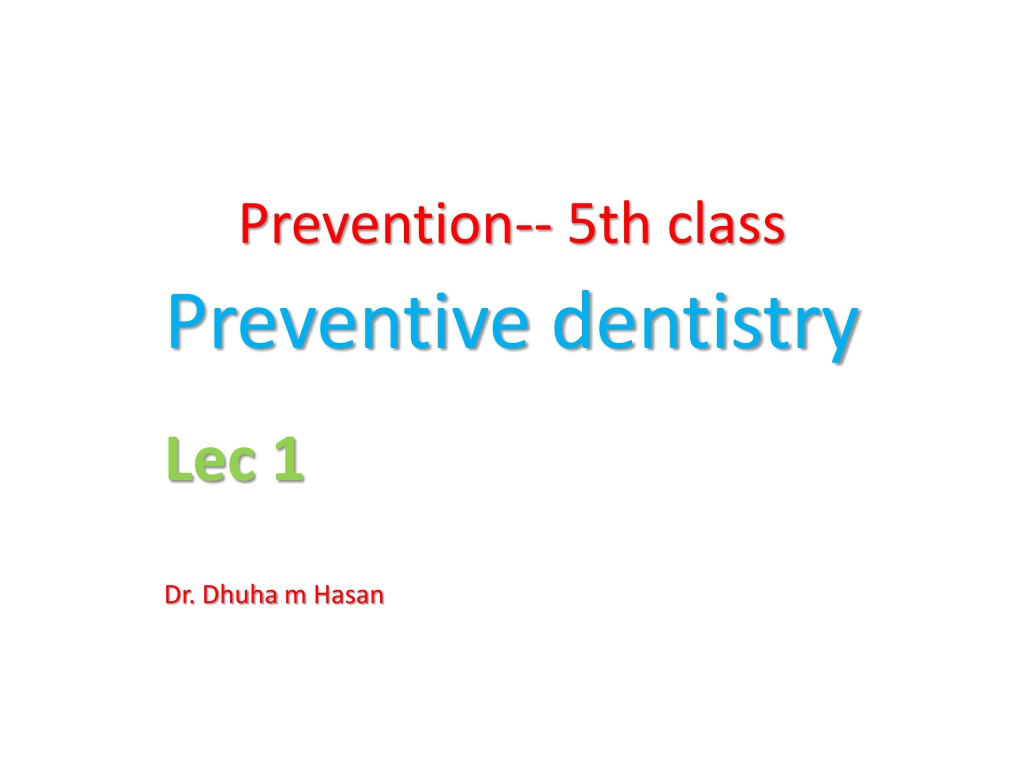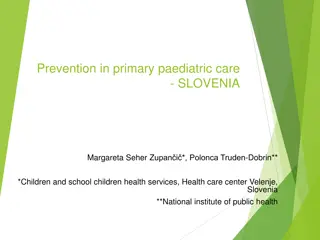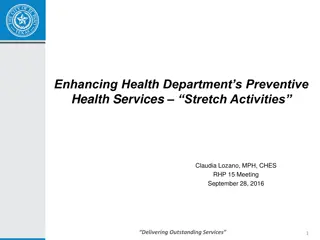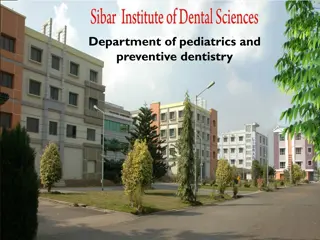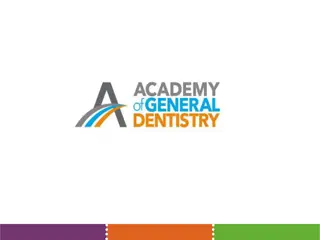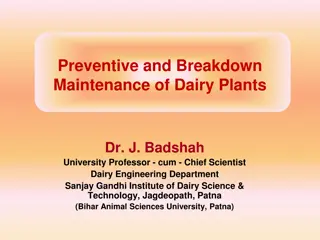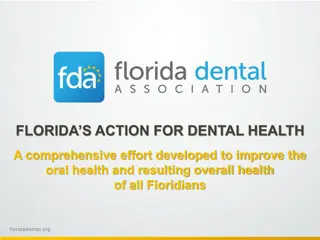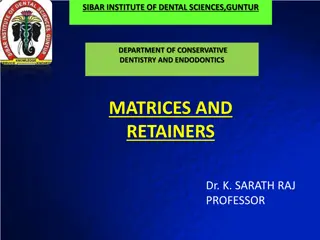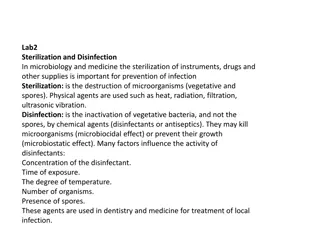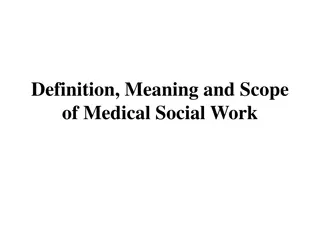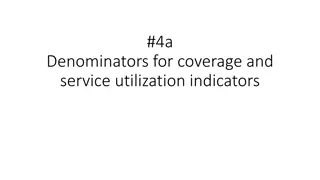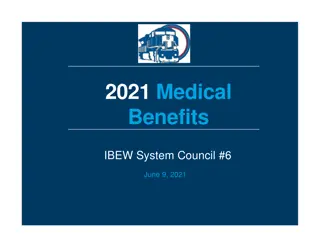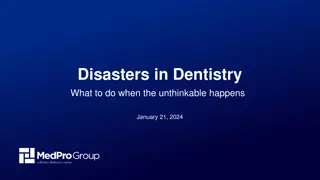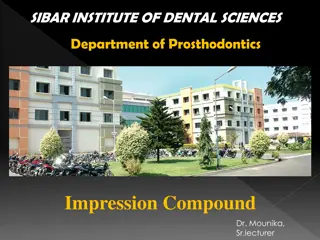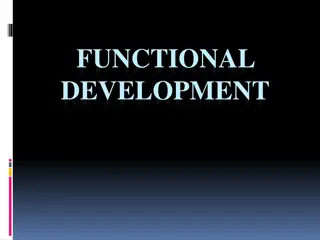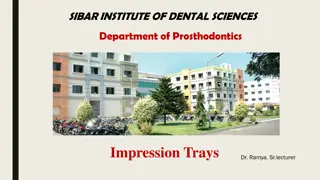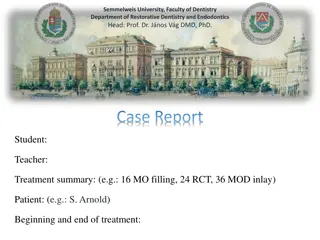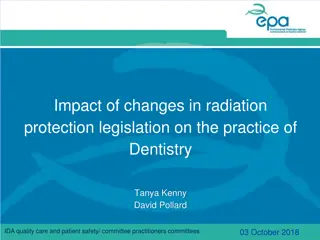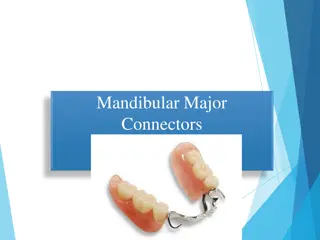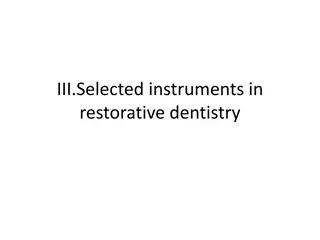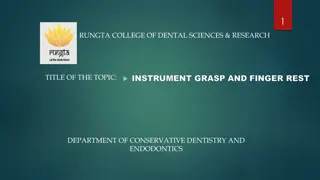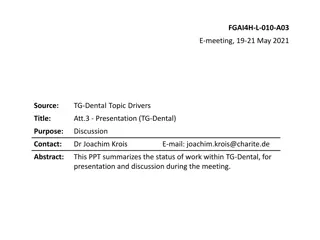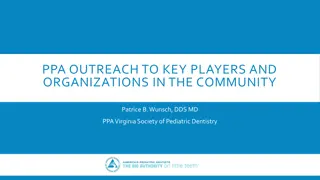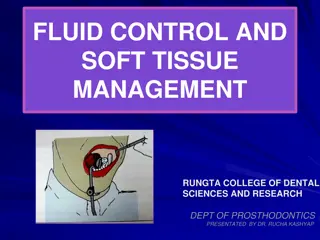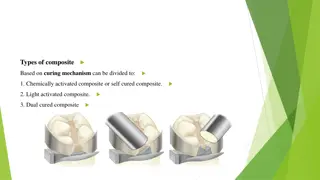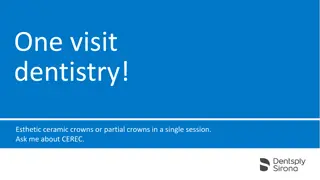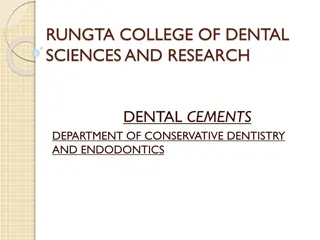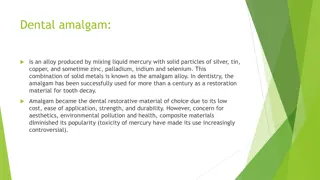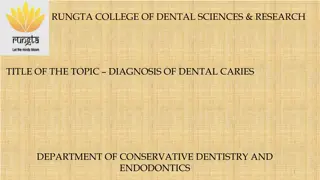Importance of Preventive Dentistry in Modern Healthcare
Preventive dentistry is crucial in anticipating and preventing dental issues before they develop, promoting overall health and well-being. With advancements in dental care, the focus has shifted to encompass a wider range of preventative measures to address various oral health concerns, especially in aging populations. From primary prevention to primordial prevention, the goal is to maintain a disease-free environment and improve oral health outcomes for individuals and societies alike.
Uploaded on Oct 01, 2024 | 0 Views
Download Presentation

Please find below an Image/Link to download the presentation.
The content on the website is provided AS IS for your information and personal use only. It may not be sold, licensed, or shared on other websites without obtaining consent from the author. Download presentation by click this link. If you encounter any issues during the download, it is possible that the publisher has removed the file from their server.
E N D
Presentation Transcript
Prevention-- 5th class Preventive dentistry Lec 1 Dr. Dhuha m Hasan
Preventive dentistry has its roots from the Latin terms praevenire, which means to anticipate and dens, which is the word for tooth. Dentists and their team members strive every working day to anticipate what could happen to their patients teeth and supporting structures. This definition assumes that the thing being prevented is anticipated, but it does not mean that the extent, severity, or extent of the thing is always known. Prevention in health care means action to stop ill health before it begins. In dealing with disease, prevention is better than a cure.
Is preventive dentistry still needed? As decay rates decline, dentists turn their interest to previously underutilized therapies such as cosmetic dentistry, orthodontics, third molar extractions, implant dentistry, and so on that need improved preventive care On the other hand people are keeping most of their teeth into old age and living longer, which means that preventing root caries, periodontal disease, and oral cancer will be even more important than before. The frail elderly is the fastest growing segment of the population, and they will need even more preventive care because of their increased risk for disease.
Dental disorders are an enormous burden to society, especially when considers the connection between poor oral health and systemic illness
Levels of prevention 1-Primordial prevention It is the prevention of emergence or development of risk factors (beginning with change in social and environmental conditions) in countries or population group in which they have not yet appeared. Individual and mass education is main intervention method in primordial prevention.
Primary Prevention (Pre- pathogenesis) It is defined as action taken prior to the onset of the disease, which removes the possibility that a disease will even occur . It is carried out on healthy populations. Information and / or public health measure for the whole population may be sufficient to maintain a disease free environment, this is the goal of primary prevention. Through primary prevention it is possible to anticipate disease and prevent it altogether. Primary preventive services are those that prevent the initiation of disease .It may be accomplished by measures designed to promote general health and wellbeing or by specific protective measures:
a. Health promotion: It is process of enabling people to increase control over and to improve health. This can be achieved by 1) Health education; instruction on proper plaque removal, daily tooth brushing and flossing 2) Environment modification such as safe water, control of insects 3) Nutritional interventions: improvement of nutrition in vulnerable group. 4) Lifestyle and behavioral changes; which favor health
b. Specific protection: These are activities designed to protect against disease agents by decreasing the susceptibility of the host or by establishing barrier against agents in the environment. Methods include immunization, use of specific nutrition, avoidance of allergens, protection from carcinogens, the use of fluoridated toothpaste and application of pit and fissure sealants.
Secondary prevention (Pathogenesis: Initial Stage of Pathogenesis): It can be defined as actions which halts the progress of a disease at its incipient stage and prevents complications . The focus of secondary prevention is early disease detection, making it possible to prevent the worsening of the disease and the emergence of symptoms, or to minimize complications and limit disabilities before the disease becomes severe. Secondary prevention ( caution ) suggests that the disease has started but can be reversed, and good health can still be achieved through intervening early, when the disease is just starting, and returning the subject to good health. For example Secondary prevention includes the detection of disease in asymptomatic patients with screening or diagnostic testing and preventing the spread of communicable diseases
Other example include when incipient enamel lesions(white spot enamel lesions) can be arrested and reversed using appropriate preventive measures and are reversed before cavities form, other example gingivitis can be reversed before periodontitis sets in, it was well established that frequent oral hygiene reinforcement by dental professionals can prevent caries, gingivitis, and periodontal disease. Secondary prevention of oral cancer could include identification of dysplastic tissue and its removal as well as stopping the irritation that leads to the dysplasia. When dysplasia is found and excised before cancer develops, thus returning to good health and controlling dental disease is possible. To prevent oral cancer, alternatives to biopsies used for early detection and surgical removal are only now being explored. These include various molecular based diagnostic markers.
Tertiary Prevention (Pathogenesis: Late Stage of Pathogenesis) Actions taken when the disease process has advanced beyond its early stages i.e. intervention in late pathogenesis phase. It can be defined as all measures available to reduce or limit impairments and disabilities, minimizing suffering caused by existing departures from good health and to promote the patients adjustment to irremediable conditions . The goal of tertiary prevention is to reduce the negative impact of an already-established disease by restoring function and reducing disease-related complications (prevent further complications or death).Tertiary prevention also aims to improve the quality of life for people with disease.
Tool for tertiary prevention include rehabilitation Rehabilitation: It is defined as the combined and coordinated use of medical, social, educational, psychological and vocational measures for training and retraining the individual to the highest possible level of functional ability. Examples of rehabilitation: Special schools for blind pupils, provision of aids for crippled, reconstructive surgery and modification of life for cardiac patients. In dentistry, tertiary prevention measures include replacement of missing teeth with bridges, implants, or dentures
Caries prevention: how far it had come in one century! If one considers that the terminal stage of caries is the loss of a tooth, then early intervention is obviously desirable. When the disease has progressed significantly and more drastic measures are required (such as root canal therapy), one is still preventing tooth loss. This was the goal in the early days of dentistry more than a century ago when Dr. G.V. Black proposed the Extension for Prevention concept during the restoration of teeth
It has taken over a century for dentistry to advance from the pioneering extension for prevention concepts proposed by Dr. G.V. Black. By removing a significant proportion of tooth structure so that only the easily cleansed tooth surfaces remained, there was a reduction in the need for further operative treatment. As dental decay rates began to fall worldwide in industrialized countries after Second World War, a new concept of operative dentistry began to take hold. It is called Minimal Intervention Dentistry (MID), as the term suggests, refers to a principle of treatment in dentistry in which early intervention minimizes tooth destruction because the disease is diagnosed prior to cavitation, and steps are taken to remineralize the enamel and arrest the decay. However, more than that assessing caries risk can be done in several ways using many different approaches include:
A thorough analysis of patient history (social, medical, and dental), followed by a careful extra- and intraoral examination will provide the necessary background for assessing caries risk in order to determine the most appropriate preventive therapy. Changing dietary patterns, controlling the cariogenicity of the oral microflora, and providing a healthy environment for remineralization are primary goals of MID.
Dental caries development The term dental caries (tooth decay or cavity) is used to describe the results (the signs and symptoms) of a localized chemical dissolution of the tooth surface caused by metabolic events taking place in the biofilm (dental plaque) covering the affected area. It is a multifactorial disease characterized by demineralization of the mineral components and dissolution of the organic matrix . The destruction can affect enamel, dentin and cementum. Carious process is the result of an interaction of the following: 1- Host. 2- Plaque. 3- Diet. 4- Time. The multifactorial complexity of dental caries can be explained simply by the following figure:
Factors affecting caries process: Host Factor: This involves susceptible tooth and saliva. The tooth: Several factors affecting tooth susceptibility are:
1- Morphology of teeth: Dental caries lesions may develop at any tooth site in the oral cavity where a biofilm develops and remains for a period of time. Such sites include pits, grooves and fissures in occlusal surfaces, proximal surfaces cervical to the contact point/area and along the gingival margin. These are the sites where lesion development is more likely to occur because the biofilm is allowed to stagnate there for prolonged time . Other areas in the oral cavity are relatively protected from dental caries due to the mechanical influence from the tongue, the cheeks, abrasive foods and tooth brushing but the insertion of foreign bodies to the dentition (e.g. fillings with inappropriate margins, dentures, orthodontic bands) may also result in dental caries in these protected sites.
Certain surfaces of a tooth are more prone to caries whereas other surfaces rarely show caries. For example, in mandibular 1st molars the caries in descending order is occlusal, buccal, mesial, distal and lingual. The differences in caries rates of various surfaces on the same tooth are in part due to morphology.
2- Position of teeth: Anterior teeth are less affected by dental caries compared to posterior teeth. The most susceptible permanent teeth are the mandibular first molars, followed by the maxillary first molars and the mandibular and maxillary second molars. The second premolars, maxillary incisors and first premolars are the next in sequence. While the mandibular incisors and canines are the least susceptible teeth to develop caries.
3- Composition of teeth: The tooth is composed mainly of inorganic elements (96% in enamel and 70% in dentin) and the remaining are organic materials and water. Composition of teeth is affected by environmental factors (water, diet and nutrition). Inorganic components involve: Major elements: calcium, phosphorous, hydroxyl group {Ca10 (PO4)6(OH)2} hydroxyapatite crystals. Minor elements: Zinc, copper, strontium, magnesium, fluoride, etc. These elements may incorporate the tooth during tooth formation or incorporate the outer enamel surface later after eruption. Furthermore, these elements may incorporate the enamel crystal in substitutions with one of its major elements. Some of these elements may increase the resistance to caries like fluoride, zinc and others. While other elements such as magnesium may increase the susceptibility of teeth to caries. It had been found that substitution of hydroxyl group by fluoride ion results in formation of fluoroapitite crystals {Ca10 (PO4)6F2} that increase tooth resistance to caries. The accumulation of these elements will results in changes of the enamel (decrease in density and permeability, an increase in fluoride content) with age.
The organic constituents and water of both enamel and dentin may act as a diffusion pathway for bacterial acids increasing the tooth destruction. In other way, they permit the penetration of ions for physiological remineralization- demineralization process. Such voids in enamel as well as proteins act as a caution for intense biting pressure to prevent fracture.
Saliva: through its secretion and composition affects dental caries development. It can affect the number of microorganisms through cleansing action (oral clearance), While buffer system in saliva affects the integrity of teeth as well as calcium and phosphate. Dental plaque: The cariogenic bacteria in plaque consist of mutans streptococci, lactobacilli and other types. Bacteria ferment carbohydrate causing release of acid lead to demineralization of tooth surface. Plaque accumulation may show individual variations and affected by many factors such as age and practices of oral hygiene.
Diet: It may exert an effect on caries locally in the mouth by reacting with the enamel surface and by serving as a substrate for cariogenic microorganisms. Frequent consumption of sweets between meals lead to continuous drop of pH, thus demineralization will occur.
Terminology of caries Dental caries may be classified in a number of ways, according to their anatomical sites. -Primary caries is used to differentiate lesions on natural, intact tooth surfaces from those that develop adjacent to a filling material. - Recurrent or secondary caries is a lesion developing at a tooth surface adjacent to a filling. - Pits and fissures caries is a lesion affected pits and fissure sites of tooth surfaces. - Smooth surfaces caries is lesion that may start on smooth enamel as buccal/labial or interproximal surfaces - Arrested caries is a lesion that may have formed years previously and then stopped further progression. - Rampant caries is the name given to multiple active carious lesions occurring in the same patient. - Nursing bottle caries is one type of rampant caries in the primary dentition of infants and young children, result from a sleep sucking bottle. - Root caries is lesion on the exposed root cementum and dentin.
Dynamics Process of De-/Remineralization Dental caries is a disease that is manifested as a dynamic process of de/remineralization in the mouth (Enamel sieve concept). The first stage of demineralization is occurring at the atomic level far before it can be seen visually as gross demineralization. During this step, fermentable carbohydrates are metabolized by bacteria in dental plaque to produce organic acids. The acids diffuse into the dental hard tissue through the water among the crystals and could reach a susceptible site on a crystal surface. Calcium and phosphate are dissolved into the surrounding aqueous phase between the crystals. This is considered as the first step in the progress of the dental caries process which can eventually lead to cavitation.
The oral fluids (saliva, biofilm fluid) have calcium (Ca) and phosphate (P) in supersaturated concentrations with respect to the mineral composition of enamel. At physiological conditions (a neutral pH of 7), low ion concentrations are sufficient to keep dental hard tissues in equilibrium. If the pH drops because of acid produced by the dental plaque, higher ion concentrations are needed to prevent dissolution of dental hard tissue. Calcium (Ca) and phosphate (P) ions are continually deposited on the enamel surface or redeposit in enamel areas where they were lost. At a pH of 5.5, under saturation begins, that is, the calcium and phosphate ion concentrations in the plaque fluid are not sufficient to maintain the enamel in stable equilibrium; thus, the enamel starts to dissolve. Demineralization is a continual imbalance between pathological and protective factors that results in the dissolution of apatite crystals and the net loss of calcium, phosphate, and other ions from the tooth.
The term remineralization is used to describe mineral gain. Remineralization is the body s natural repair process for subsurface non-cavitated carious lesions. In the process of remineralization, calcium and phosphate ions are supplied from a source external to the tooth to promote ion deposition into crystal voids in demineralized enamel to produce net mineral again. De-/remineralization cycles continue in the mouth as long as there are factors including cariogenic bacteria, fermentable carbohydrates, and saliva. The balance between pathological factors and protective factors determines whether demineralization or remineralization is proceeding at any one time.
The development of a carious lesion occurs in three distinct stages: - The earliest stage is the incipient lesion; macroscopically evidenced on the tooth surface by the appearance of an area of opacity (the white spot lesion), which is accompanied by histologic changes of the enamel at the microscopic level and is well established with a number of recognizable zones. - The second stage includes the progress of the demineralization front toward the dentino-enamel junction and/or into the dentin; the affected dentin displays discoloration from brown to dark brown or black, microscopic changes of dentin showed different zones. - The final phase of caries development is the development of the overt or frank lesion, which is characterized by actual cavitation.
